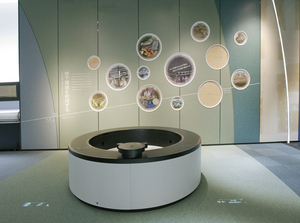Nagoya City Science Museum
TOP > Exhibition Guide > Floor Map> "Geo - projects"
"Geo - projects"



Purpose of Exhibition
We would like to introduce the current research, not for making a similar artificially convenient environment in the underground, but for using the actual underground environment which does not exist above the ground.
Additional Knowledge
When you think of the uses for the underground, you might imagine making a convenient environment similar to above the ground or infrastructure construction in city areas. However, in addition, we depend more and more on mining resources for saving and conserving energy as well as the treatment of waste. We need to understand the function and character of the underground environment to employ clever- use techniques.
[The Transportation System]
The underground space is used for infrastructures such as common utilities and water and sewer services in modern cities. A legitimate route of transportation network and product distribution system can be set up because the enactment of the law enables us to use the deep underground, especially for highly public projects. The Linear Chuo Shinkansen is under consideration to run through deep underground.
[Geothermal Power]
Geothermal power is a way of generating power by extracting hot water from deep underground. Although Japanese geothermal resources are enormous, the electrical energy produced using it (about 530 thousand kW) is only 1 percent of the total produced energy. This is because there is a restriction of development and risks that not enough hot water or vapor come out. Moreover, the prominent places are already designated as national parks and we cannot simply destroy the natural conservation or the landscape. There are constraints on developments, however, emission of carbon dioxide is small compared with fossil-fuel power stations, and demand for geothermal power becomes more and more important.
[The Use of Underground Water]
Underground water is used in many ways such as industrial water and daily life water. Recently, heat pumps are used because the water temperature is stable. It is also used to provide backup water supply. For example, if the water supply is interrupted when a disaster occurs, it takes more time to recover compared with the electricity or phone system. In this type of emergency, it is good to have an underground water system (well water). The progress of technology enables us to excavate deep well water easily and it has started to be used in hospitals.
[The Scientific Experiment Facility]
The underground environment is used for scientific experiment facilities. A typical facility is the "Super-Kamiokande" in Kamioka Town, Hida City and Gifu Prefecture. The neutrinos bursts from supernova explosion were successfully observed for the first time in the world in the facility and it became famous. Dr. Masatoshi Koshiba went on to win the Nobel Prize. The neutrinos pass through rocks as well as block other cosmic rays which interfere with the observation. Other than this, research to understand subterranean microorganisms, underground water and the technique of underground excavation is being done at various underground experiment facilities around the world.
[The Investigation for Underground Resources]
We use a variety of underground resources, from mineral resources such as gold and silver and rare earth, to fossil fuel such as petroleum and natural gas by excavating the useful minerals concentrated place (deposition). In order to explore and reserve underground resources, we need to know concentrating mechanism of these materials by subsurface phenomenon .
[Stock of Petroleum and LP Gas]
Japan depends on imported petroleum and LP gas which we consume. To ensure these supplies remain stable, petroleum and LP gas are stocked. Those are blocked in holes, which are made by excavating in tough rock like granite, used as tanks by water pressure from underground (water seal). Compared with tanks in the ground, a large amount of land is not needed and huge amounts of petroleum and LP gas can be kept underground.
[Carbon Capture and Storage (CCS)]
It is said that there are limitations to cutting the carbon dioxide emissions - greenhouse gases - by energy saving. Therefore, one technique is to collect and save carbon dioxide safely underground without emitting it in to the air (refer to details in the other article).
[Radioactive Waste Deep Geological Repository]
Radioactive waste is generated when nuclear power using nuclear fuel is produced. The problem to solve is the treatment for the radioactive waste which has accumulated by generating electricity for a half century so far. Therefore, the preferred way for the treatment of high level radioactive waste is "deep geological repository". The separation from the human living environment for a long time is deliberated by being buried 300 meters deep underground after the radioactive waste is glass-fixed, cooled down and saved in a facility for 30-50 years.
[Research of the Underground Biosphere]
Although it was thought that living creatures don't exist in the deep underground, it is now known that there is a large quantity of microorganisms. It is said that from one million to one hundred million microorganisms per cup live and microorganisms which do not exist in the sea can be found there. Those microorganisms may produce the source of petroleum or natural gas, or affect our human living environment in a good way by helping to improve it. Some scientists research from the beginning of the life of underground creatures. Research of deep biosphere has just begun.
Article by Shoji Nishimoto, curator
